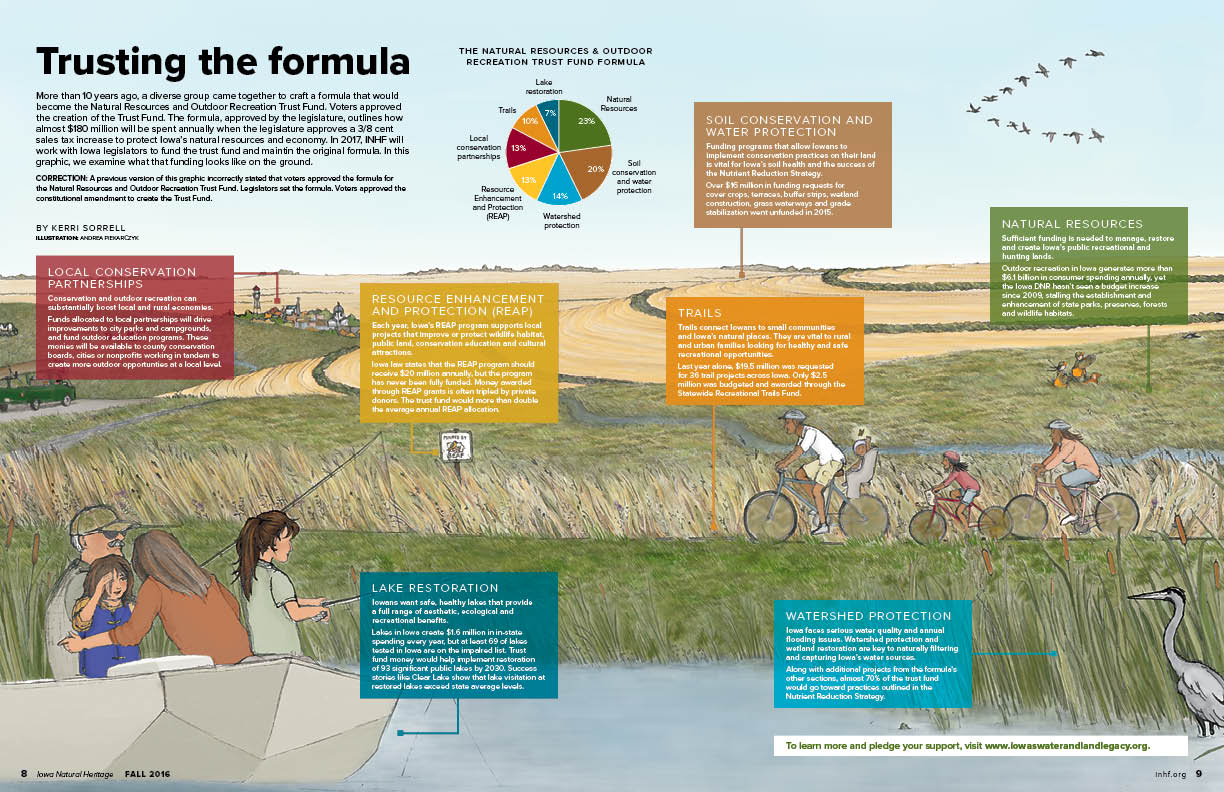Trusting the formula
By Kerri Sorrell on December 29, 2016 in Blog
More than 10 years ago, a diverse group came together to craft a formula that would become the Natural Resources and Outdoor Recreation Trust Fund. Voters approved the creation of the Trust Fund. The formula, approved by the legislature, outlines how almost $180 million will be spent annually when the legislature approves a 3/8 cent sales tax increase to protect Iowa’s natural resources and economy. In 2017, INHF will work with Iowa legislators to fund the trust fund and maintain the original formula. In this graphic (see below), we examine what that funding looks like on the ground.
CORRECTION: A version of this graphic that ran in Iowa Natural Heritage magazine incorrectly stated that voters approved the formula for the Natural Resources and Outdoor Recreation Trust Fund. Legislators set the formula. Voters approved the constitutional amendment to create the Trust Fund.

View a larger version of the graphic.
Local conservation partnerships (13%)
Conservation and outdoor recreation can substantially boost local and rural economies.
Funds allocated to local partnerships will drive improvements to city parks and campgrounds, and fund outdoor education programs. These monies will be available to county conservation boards, cities or nonprofits working in tandem to create more outdoor opportunities at a local level.
Resource Enhancement and Protection - REAP (13%)
Each year, Iowa’s REAP program supports local projects that improve or protect wildlife habitat, public land, conservation education and cultural attractions.
Iowa law states that the REAP program should receive $20 million annually, but the program has never been fully funded. Money awarded through REAP grants is often tripled by private donors. The trust fund would more than double the average annual REAP allocation.
Soil conservation and water protection (20%)
Funding programs that allow Iowans to implement conservation practices on their land is vital for Iowa’s soil health and the success of the Nutrient Reduction Strategy.
Over $16 million in funding requests for cover crops, terraces, buffer strips, wetland construction, grass waterways and grade stabilization went unfunded in 2015.
Trails (10%)
Trails connect Iowans to small communities and Iowa’s natural places. They are vital to rural and urban families looking for healthy and safe recreational opportunities.
Last year alone, $19.5 million was requested for 36 trail projects across Iowa. Only $2.5 million was budgeted and awarded through the Statewide Recreational Trails Fund.
Natural resources (23%)
Sufficient funding is needed to manage, restore and create Iowa’s public recreational and hunting lands.
Outdoor recreation in Iowa generates more than $6.1 billion in consumer spending annually, yet the Iowa DNR hasn’t seen a budget increase since 2009, stalling the establishment and enhancement of state parks, preserves, forests and wildlife habitats.
Lake restoration (7%)
Iowans want safe, healthy lakes that provide a full range of aesthetic, ecological and recreational benefits.
Lakes in Iowa create $1.6 million in in-state spending every year, but at least 69 of lakes tested in Iowa are on the impaIred list. Trust fund money would help implement restoration of 93 significant public lakes by 2030. Success stories like Clear Lake show that lake visitation at restored lakes exceed state average levels.
Watershed protection (14%)
Iowa faces serious water quality and annual flooding issues. Watershed protection and wetland restoration are key to naturally filtering and capturing Iowa’s water sources.
Along with additional projects from the formula’s other sections, almost 70% of the trust fund would go toward practices outlined in the Nutrient Reduction Strategy.
To learn more and pledge your support, visit www.iowaswaterandlandlegacy.org.